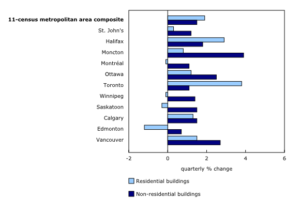
Building costs on the rise
By Adam Freill
Commercial Construction Industrial Institutional ResidentialSecond-quarter construction price indexes increase for both residential and non-residential projects, according to StatCan.

Building construction price indexes, quarterly change, second quarter of 2023. (Source: Statistics Canada, Table 18-10-0276-02.)
The rise in building construction costs continued in the second quarter of 2023, reports Statistics Canada. Residential costs were up 1.9 per cent on the quarter, which followed 1.8% growth in the previous quarter. Non-residential costs were also up, rising 1.5 per cent for the quarter. That sector was up 1.7 per cent in the first quarter of the year.
Year-over-year, construction costs for residential buildings in the 11 Census Metropolitan Areas (CMA) included in the composite were 7.5 per cent higher in Q2 of this year versus last year. Non-residential building construction costs were slightly lower, coming in at seven per cent. On the residential side, Toronto was hit hardest with a 13 per cent increase over this time last year. Moncton led on the non-residential side, with a rise of 12.5 per cent.
Skilled labour shortages, cost of materials and labour rate changes were reported by contractors as key factors impacting the construction sector. Diverging price movements of key construction materials impacted residential construction costs, says StatCan. In the second quarter, prices continued to rise for cement and ferrous metals, while they declined for lumber, plastics and non-ferrous metals.
Rising prices for structural steel framing had the greatest impact in the costs for non-residential building construction, followed by concrete and metal fabrications. Of all non-residential buildings surveyed, the cost to build factories and warehouses (both up 1.8 per cent) rose the most in the 11-CMA composite.




